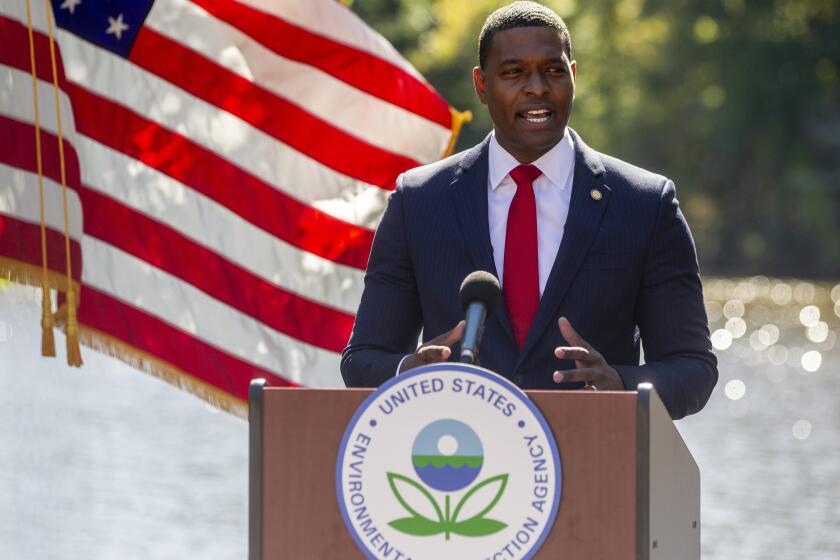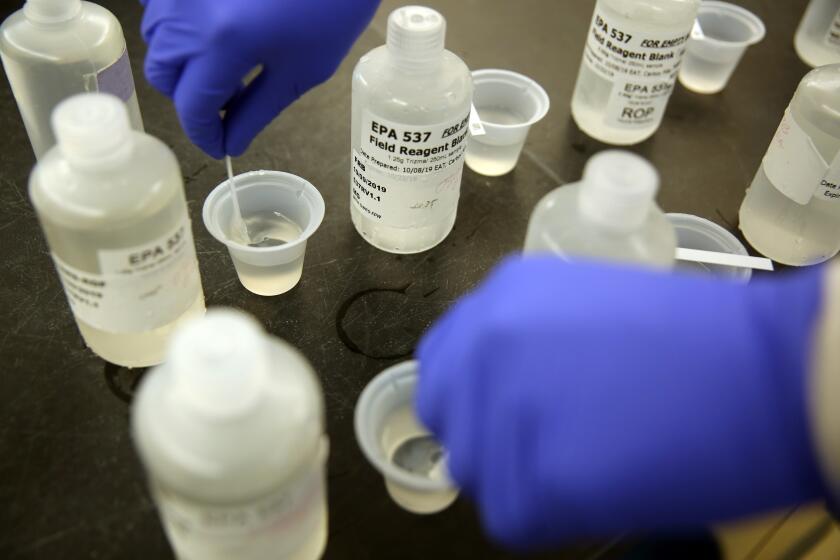Risk of tap water exposure to toxic PFAS chemicals higher in Southern California

Tap water in urban areas of Southern and Central California appears more likely to be contaminated by PFAS “forever chemicals” than drinking water in many other regions of the nation, although rural Californians are far less likely to suffer similar exposure, according to new research by the U.S. Geological Survey.
The newly released study is the latest to examine the prevalence of per- and polyfluorinated alkyl substances — a vast group of manufactured chemicals that are drawing increasing scrutiny for their health risks, as well as their widespread prevalence in food, water, soil, air and work environments.
In what is considered to be the nation’s first large-scale analysis of PFAS in tap water from private wells and public water supplies, researchers estimated that at least 45% of drinking water across the nation could contain one or more of the chemicals. Study authors also concluded that drinking-water exposures may be more common in Southern and Central California, as well as the Great Plains, Great Lakes and Eastern Seaboard regions.
While study authors found an 8% probability that one or more of the chemicals would be detected in drinking water in rural areas, the detection probability skyrocketed to more than 70% in urban areas.
Kelly Smalling, research hydrologist with the U.S. Geological Survey and the study’s lead author, said town and city residents are more likely to be exposed to PFAS because there are more people using everyday items that contain them. “There’s also more airports, industrial activities, military installations, even wastewater treatment plants that are all known sources,” she said.
Known as “forever chemicals” because they don’t degrade naturally in the environment, PFAS have been used since the 1940s and are ubiquitous. They can be found in such everyday items as nonstick cookware, dental floss, period underwear, fast food boxes, water-repellent clothing and firefighting foam.
Although their use has mostly been phased out in the U.S., their prevalence in the environment remains a concern. Exposure to high levels of some PFAS has been linked to adverse health effects such as decreased fertility, increased risk of high cholesterol, obesity, high blood pressure, certain cancers, and liver and immune-system damage.
Smalling said a key finding of the study was learning that PFAS concentrations were similar in samples collected from domestic wells, which are not government-regulated, and public water suppliers, which are.
“The important thing about this study is that it emphasized the importance of collecting data on PFAS from private well users… [which] tend to be monitored at the discretion of the homeowner,” she said.
The EPA is proposing the first federal limits on harmful “forever chemicals” in drinking water, saying it could prevent thousands of illnesses.
The study comes at a time of increasing concern and visibility around the prevalence, toxicity and cost of removing these “forever chemicals.”
Recently, the chemical manufacturer 3M reached a $10.3-billion deal to settle lawsuits over PFAS contamination in many U.S. public drinking water systems.
Last year, the Environmental Protection Agency issued updated health advisories after new science suggested that certain PFAS posed adverse health effects even with near-zero concentrations.
And in March, the EPA proposed strict federal limits on two common types of PFAS — PFOA and PFOS — in drinking water to the lowest levels that tests can detect, and said it wanted to regulate four more. The agency said the rule would protect thousands of lives, prevent serious illness, and reduce exposure for nearly 100 million Americans.
But the U.S. Geological Survey study found that tap water levels of PFOA and PFOS in both private and public supply exceeded federally proposed limits and benchmarks.
Over a five-year period, researchers tested for 32 of more than 12,000 types of PFAS from 716 nationwide residences, businesses and drinking-water treatment plants from urban, rural and protected regions, such as national parks, conservation areas as well as U.S. Fish and Wildlife Service lands. (Current testing capabilities cannot test for all PFAS.)
Of the samples taken, 269 were from private wells and 447 from public supply systems. Scientists used those data to model and estimate PFAS contamination across the country.
Toxic chemicals linked to cancer have been found in dozens of California water systems. Here are some often-asked questions residents have about how to limit their exposure and reduce the level of PFAS in their tap water.
In California, public water systems are required to test for the chemicals if they are near potential PFAS sources like landfills, airports and military bases, and if they are in proximity to other water sources with confirmed contamination.
Water systems that detect PFAS above notification levels are required to alert customers. If they exceed a response level, which is higher, it must stop using the contaminated water source, install treatment, or notify the public that it will continue serving it.
“We are concerned about [PFAS] like everybody else,” said Darrin Polhemus, deputy director and head of the California State Water Resources Control Board’s division of drinking water. “And it’s definitely an issue we’re working towards addressing and putting regulations forward on it.”
In Southern California, PFAS concentrations tend to come from downstream wastewater treatment plants that discharge to local rivers and recharge water back into groundwater, which eventually gets picked up and becomes drinking water, Polhemus said. PFAS-contaminated drinking water is particularly prevalent in disadvantaged communities, according to a 2021 study by the Natural Resources Defense Council.
“They’re not going away, unfortunately... And there are going to be a lot of water systems that have to deal with them, and we’re working on trying to understand how to treat them,” Polhemus said. “In California, my hope is that we can develop a treatment approach that addresses the vast majority of them so that we don’t have to write a maximum contaminant level for hundreds of PFAS if that’s truly what we detect — so that we can have communities invest in treatment once and use that for their protection.”
While Smalling noted that the USGS is an unbiased science organization that has not conducted research on the health impacts of PFAS, she hopes the study “can help members of the public to really understand their risk of exposure, as well as inform policy and management decisions regarding potential testing and treatment options for drinking water now and into the future.”
The Los Angeles Times reviewed hundreds of pages of Pentagon documents and found California has more bases contaminated with the chemicals, known as PFAS, than any other state — at least 21 that exceed federal health guidelines.
Jennifer Clary, water policy and legislative analyst for the nonprofit Clean Water Action, called the study’s findings “disappointing but not really surprising… It just lets you know what a problem it is when you use chemicals that you don’t really understand the outcome of, like what happens when they get out into the environment.”
The organization, which operates programs across the country, has been working with legislators, communities, agencies, industries and water regulators to get PFAS out of products and drinking water, she said.
While California legislators have banned PFAS from firefighting foam and implemented public health goals for certain chemicals, Clary believes they’re not doing enough.
“Given their potential harm and their almost universal presence in our drinking water, we really need to treat this like an emergency situation, and we really should be taking strong steps to identify where PFAS is,” she said.
Clary also said the study highlighted a broader pattern around how products are manufactured and what is used to make them.
“An ounce of prevention is worth a pound of cure. How do we make decisions about what we use in our production so that we don’t always have to deal with this?” Clary said. “PFAS is the biggest example but it’s not like we haven’t had warnings of it all along the line with pesticides, with additives, with gasoline.
“And now we get something that’s used everywhere, so we find it everywhere, and we shouldn’t be surprised,” she added. “But we should be concerned about how we as a society are considering how we produce the goods that we use.”
Watch L.A. Times Today at 7 p.m. on Spectrum News 1 on Channel 1 or live stream on the Spectrum News App. Palos Verdes Peninsula and Orange County viewers can watch on Cox Systems on channel 99.
More to Read
Sign up for Essential California
The most important California stories and recommendations in your inbox every morning.
You may occasionally receive promotional content from the Los Angeles Times.















